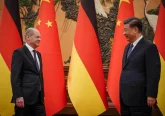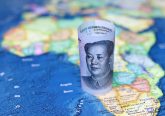
East Asia’s rapid economic and military development has captured global attention, but pundits are quick to point to the South China Sea, North Korea, and Taiwan as potential obstacles to the region’s continued growth. Analysis of news coverage demonstrates that regional economies and tensions have been growing in tandem. The South China Sea has historically been of particular interest because of the number of conflicting claims on the islands and sea-lanes it encompasses. China, Malaysia, Brunei, the Philippines, Vietnam, and Taiwan, among others, have often engaged in bilateral disagreements with resulting spikes in diplomatic tension and even military confrontation. Of note, these conflicts have never escalated to a full-scale regional war. Direct extrapolation suggests that previous restraint in military interactions implies the nations involved do not consider the potential benefits sufficient to justify an upset to the balance of power. However, contemporary changes in economic and security conditions complicate the issue. While current tensions appear unlikely to lead to a full-scale military conflict, the diversion of national resources needed to maintain the status quo is substantial. Institutional changes to increase transparency; clarify US treaties with ASEAN nations; and increase states’ internal enforcement of international agreements, although initially costly, would allow the neighbouring states to redirect these resources to long-term growth.
Historically, China has been involved in a majority of the military conflicts in the South China Sea. A 1947 Chinese map delineates China’s controversial claim to approximately 80% of the sea. China aggressively used its navy to conclude a dispute with Vietnam in the Battle of the Paracel Islands in 1974 and then in 1988 during the Johnson South Reef Skirmish for the Spratly Islands. Conflict was narrowly averted in 1995 when the Philippines chose not to shell fort-like Chinese military structures on Mischief Reef (China maintained they were only intended as shelter for fisherman); however, the Philippines continues to assert that this is an example of “creeping occupation”. This form of venting tensions, while far short of total war, is extremely costly over the long run; the combination of of resources, energy, and lives expended to establish a claim to the islands creates a significant and avoidable opportunity cost. These skirmishes are not merely an imprint of the 20th century but continue today as witnessed by the Chinese establishment of the Sansha garrison-city in 2012 and the Sino-Philippines stand-off in the Scarborough Shoal.
What then is the evidence suggesting a continued reluctance to engage in full-scale military confrontation? Although in the past conflict has often arisen between economically interdependent nations (viz. the previous peak of global trade in 1914), the China-ASEAN relationship is one of fundamental interdependence of production, visible in the prevalence of international supply chaining in manufacturing processes, rather than solely trade and labour movement[i]. The burgeoning economic interdependence and growth of neighbouring states contributes a major incentive to prevent a conflagration. $5.3 trillion of trade, of which approximately 20% is US, transits the South China Sea annually and any interruption would not only severely restrict regional trade revenues, but would also very likely guarantee US military intervention[ii]. The Association of South East Asian Nations (ASEAN) is becoming increasingly interconnected and 2015 will mark a key turning point with the opening of internal ASEAN borders for free movement of labor. The ASEAN bloc has also concluded a number of reconciliation agreements with China. Regarding security, both the 2002 Code of Conduct and the 2011 Guidelines to the Code of Conduct are intended to help coordinate diplomacy and maintain peace in South China Sea disputes. Economically China has been ASEAN’s largest trading partner since 2009, and at its opening in 2010 the ASEAN-China free trade area (ACFTA) became the largest in the world by population. These arrangements come at a time when growing estimates of the value of the natural resources contained in the South China Sea are generating pressures associated with ensuring energy security.
Economic interdependence between China and ASEAN, however, is not the sole factor at play. In areas with considerable interstate tension sub-state actors have often contributed to the deterioration of international relations, most prominently with the assassination of Archduke Franz Ferdinand tipping Europe into World War I. Recent developments in state-level Chinese political and military discourse reflect a strong interest in cooperation. Chinese President Hu Jintao’s 2011 discussions with Filipino President Corazon Aquino firmly expressed the hope that “the countries concerned may put aside disputes and actively explore forms of common development in the relevant sea areas”[iii]. Additionally in 2011 the Chinese State Council Information Office released a white paper with a similar emphasis on joint development. Yet China is also reported to have developed internal fractures in its South China Sea policy, with a number of different ministries controlling paramilitary units that are not under express government oversight[iv]. For example, the Bureau of Fisheries Administration (BFA) now directs a relatively well-equipped law enforcement fleet that is tasked with patrolling Chinese-owned fishing areas. Such interest groups repeatedly instigate minor disputes with their ASEAN counterparts and the US navy that exacerbate state-level discussions and risk eventually drawing unintended consequences (characteristically, in 2004 two BFA vessels obstructed a US Navy surveillance ship in the Yellow Sea).
The region has also seen a rise in high-tech militarization, with rapid development in areas ranging from aircraft carriers and submarines to cyber-espionage; this is likely to further increase due to the 2011 US “pivot to Asia” and military surge. The pivot is considered to be a sign that the US intends to continue playing a leadership role in East Asia, a strategy at odds with China’s vision[v]. An associated complication is the imprecise definition of US commitments to its ally nations in the event of disputes in contested territories, especially vis-à-vis the Philippines and Vietnam, and the possibility that alliances will be used to escalate a small battle into a regional affair. The US is making efforts to address these complications; for the first time since RIMPACS’s creation in 1971, China has been invited to participate in a US-led naval exercise. Positive near-term repercussions of growing US involvement have also been postulated; analysts suggest that one of the root causes behind Chinese interest in cooperation is the fear that aggression in the South China Sea will drive other parties to strengthen their ties with the US[vi].
The relative wealth of economic and diplomatic compromises on all sides presents a compelling argument that under current conditions, disputes in the South China Sea will continue to be restrained to small-scale skirmishes that do not threaten overall stability. This is not to say that the increase in regional tension is insignificant, but rather that the involved parties all have a strong interest in maintaining mutual growth and have demonstrated their willingness to make strategic sacrifices to maintain the status quo. Furthermore as China is the common link in the majority of the disputes, it is probable that it will be at the heart of any conflict — and China has frequently shown restraint in this regard (though not so, for example, in Tibet). In terms of China’s priorities, policy analysts tend to agree that if China were to begin a large-scale military campaign, Taiwan would most likely be the focus of its aggression[vii].
My analysis focuses on demonstrating the likely maintenance of the status quo without large-scale war given present circumstances, as well as the high opportunity cost of this outcome. However the institution of the following policy changes can reduce both inter-state tensions and the associated recurring costs: a concerted effort to increase transparency in each nation’s territorial claims; a US declaration on the status of disputed territory conflicts in its mutual defence treaties; and internal enforcement of international agreements such as the Code of Conduct.
Establishing these proposals would be costly to all parties in the short term, in part because of the benefits nations derive from ambiguities in their claims and treaties. China has often been reluctant to precisely define its claim to territories in the South China Sea, not least because of its inconsistency with the law regarding Exclusive Economic Zones. The US intentionally used obscurity in its treaty with Japan to discourage Chinese military intervention in the East China and again in clauses of the US-Taiwan treaty concerning China. Yet ambiguity generates escalating tension as nations attempt to ascertain their positions, and increases room for misunderstanding. Ignoring for a moment China’s stated refusal to accept international moderation in the South China Sea, a possible model treaty would be the division of disputed territory by the International Court of Justice in the Qatar-Bahrain conflict over the Hawar Islands. That controversy involved similar economic incentives to the South China Sea due to the significant oil and natural gas reserves in the region of the islands, and the resolution benefited both nations as well as facilitating regional cooperation in other matters. The details of this agreement provide an interesting opportunity to disentangle nationalist and economic disputes in the South China Sea, and may become the foundation of a future China-ASEAN agreement.
Abraham Chaibi is a 3rd year visiting student from Princeton University in the Department of Engineering Science
[i] Yuan, Jing Dong. China-ASEAN Relations: Perspectives, Prospects and Implications for U.S. Interests.
[Carlisle Barracks, PA]: Strategic Studies Institute, U.S. Army War College, 2006.
[ii] Glaser, Bonnie. “Armed Clash in the South China Sea.” Council on Foreign Relations (2012). Web.
[iii] Fravel, Taylor M. All Quiet in the South China Sea. 22 March 2012. 04 Febuary 2013. <http://www.foreignaffairs.com/articles/137346/m-taylor-fravel/all-quiet-in-the-south-china-sea>.
[iv] International Crisis Group. “Stirring up the South China Sea (I).” 1 April 2012. Report. 04 Febuary 2013.
[v] Lieberthal, Kennet. “The American Pivot to Asia.” Foreign Policy Magazine (2011). Web.
[vi] Glaser, Bonnie. “Armed Clash in the South China Sea.” Council on Foreign Relations (2012). Web.
[vii] Capaccio, Tony. “China Military Continues Taiwan Focus, Pentagon Report Says.” 25 August 2011. Bloomberg. Web. 04 February 2013.







1 Comment
I agree that the claimant countries have a shared interest in maintaining mutual growth however the only reason why the skirmishes has not escalated into a full-scale war is because no claimant country is strong enough to take on China. Most of the competing countries involved have a weak military compared to China’s. And by the way, no such discussion took place between Chinese President Hu Jintao and President Corazon Aquino in 2011. The latter died in 2009.